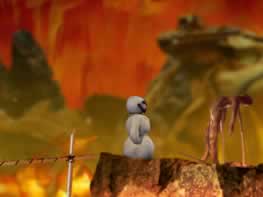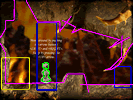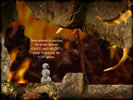Coding the Design
All began with the basic game design ideas of
a snowman melting in hell and throwing his detachable head around
as a weapon. The traditional 2D-platformer genre was chosen as
the starting point for the gameplay, as it seemed to serve the
ideas the best. Strong puzzle elements were added to maximize variation
in the application of the design.
The first demo version of the game (never released in public) had only
two levels, but all the main ideas were already clearly present. It even
featured vertical scrolling, which was dropped later on, in order to simplify
the gameplay.

A scene from an early version of the
game. The style of the background graphics has since changed significantly,
but the clay is alreay there (click to enlarge).

A screenshot from the second demo version,
which already looks much like the final game, though with larger
scale graphics. The bitmaps were made smaller later in order
to increase performance and playability (click to enlarge).
Going Beyond Physics
For the final version we decided to spice up the gameplay by implementing
some laws of physics in the game. This proved to be quite challenging,
as the balance between realism and playability was not easy to find. The
task was made more difficult by Director itself and its limitations, such
as lack of precision in operations with floating-point numbers. Another
problem was pure performance, as all the graphics, including the animations,
were constructed of heavy bitmap images.
To achieve more realistic motion of the game characters and their bouncing
off the cave walls, all mobile and immobile objects were modeled using
two-dimensional vectors. In the game the vectors are hidden behind the
visible bitmaps and animations that form the visual style of the game.
  
Discovering the vectors in the beginning
of level 1 (click to enlarge).
One of the best features that came out from the “para-realistic” physics
simulation was the ability to play around in the game, instead
of just trying to win the game. Kicking and throwing monsters can have
funny, unpredictable results as they bounce around the playfield. For
example, an elevator may be jammed by a corpse blocking its path, or
Snowman may end up wearing a dead monster as his head.
Some have claimed that we ended up with a game that is a bit too difficult,
but this was a conscious choice. Most games today are way too straightforward,
so we wanted to make this one more challenging in good retro spirit. And
after all, being a snowman in hell IS hard as hell!
Some Tech Specs
Snowman in Hell is programmed entirely using only
the basic Lingo scripting commands in Macromedia Director MX 9.0. No
additional Director extensions are used, other than the built-in Xtras.
All the scripts are created from scratch, though naturally using the
net – and the laws of physics – as
a reference. The final game includes somewhere around 5000 lines
of Lingo code.
The still images were imported as PNG bitmaps
and the animations as Flash animations. All the graphics are
2D, though a “fake 3D” effect
(also known as Parallax scrolling) is created by scrolling the
separate background and foreground layers at different speeds.
|

